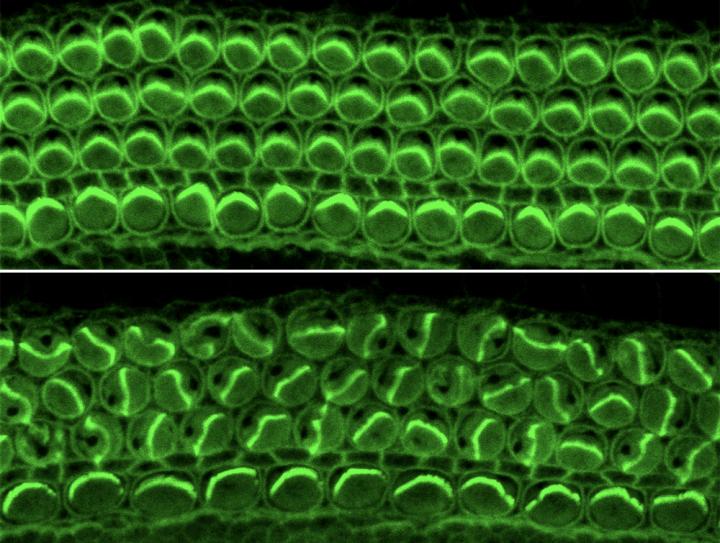New images reveal how the ear's sensory hairs take shape

To pick up these sounds, tiny hair-like filaments in the inner ear must be packed into precisely arranged bundles, all facing the same direction (top). Researchers identified a protein essential to this process. Credit: Laboratory of Sensory Neuroscience at The Rockefeller University Usage Restrictions: Image may be used only to illustrate the research described in the accompanying release.
Scientists already knew that a molecular blueprint guides the formation of upside-down V-shaped bundles on the surface of inner ear cells that detect sound, motion, and spatial orientation.
While investigating how cells draw up these blueprints, Kimberly Siletti, a graduate student in the lab, found evidence implicating a protein called Daple. It was already known to interact with a so-called compass structure, ensuring that the V-shape bundles are aligned properly to catch sound propagating through the cochlea.
Understanding these molecular orientation systems is critical because if disrupted the bundles grow facing the wrong direction, sometimes even backward. For the bundle to develop properly, the blueprint and the compass must work together.
“These two systems were discovered independently, and it isn't clear how they are coordinated,” Siletti says. “Our experiments suggest that Daple is part of the molecular machinery that links them.”
To test this hypothesis, the researchers switched off the protein in mice. The effect of this manipulation, captured in high-resolution, was conspicuous: the hair cells of animals that lacked the protein developed scrambled bundles without the distinctive V-shape (bottom image).
The scientists think Daple influences the shape of the hair bundles indirectly, by determining the position of the first filament to emerge at what becomes the apex of each bundle. If that filament is positioned improperly, the blueprint becomes warped. Their work was described in the Proceedings of the National Academy of Sciences.
Media Contact
All latest news from the category: Life Sciences and Chemistry
Articles and reports from the Life Sciences and chemistry area deal with applied and basic research into modern biology, chemistry and human medicine.
Valuable information can be found on a range of life sciences fields including bacteriology, biochemistry, bionics, bioinformatics, biophysics, biotechnology, genetics, geobotany, human biology, marine biology, microbiology, molecular biology, cellular biology, zoology, bioinorganic chemistry, microchemistry and environmental chemistry.
Newest articles

Rocks with the oldest evidence yet of Earth’s magnetic field
The 3.7 billion-year-old rocks may extend the magnetic field’s age by 200 million years. Geologists at MIT and Oxford University have uncovered ancient rocks in Greenland that bear the oldest…

Decisive breakthrough for battery production
Storing and utilising energy with innovative sulphur-based cathodes. HU research team develops foundations for sustainable battery technology Electric vehicles and portable electronic devices such as laptops and mobile phones are…

Superradiant atoms could push the boundaries of how precisely time can be measured
Superradiant atoms can help us measure time more precisely than ever. In a new study, researchers from the University of Copenhagen present a new method for measuring the time interval,…





















